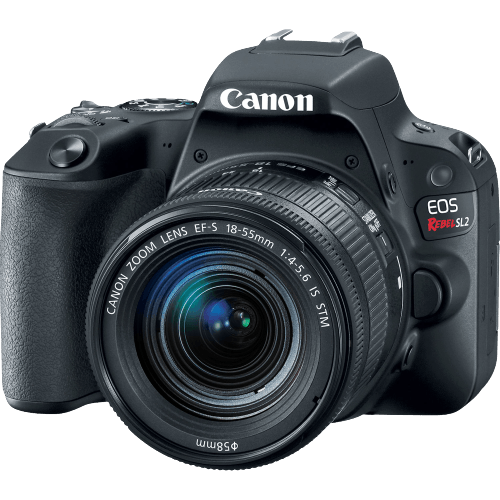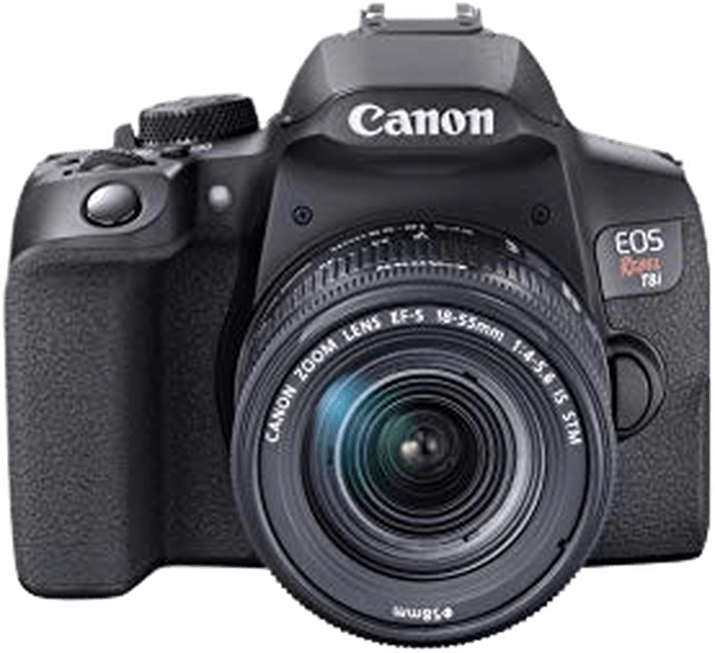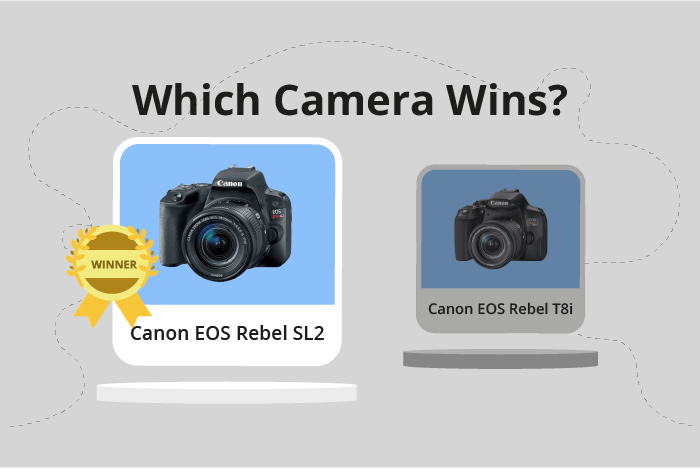Canon EOS Rebel SL2 / 200D vs EOS Rebel T8i / 850D Comparison
Canon EOS Rebel SL2 / 200D

Canon EOS Rebel T8i / 850D

The Canon EOS Rebel SL2 / 200D outperforms the Canon EOS Rebel T8i / 850D with a score of 62/100 as opposed to the T8i’s 59/100. Both cameras share the DSLR type and are made by Canon. The SL2 was released in 2017 with a launch price of $550, while the T8i came out in 2020, costing $750.
The SL2 has the advantage of being lighter, weighing 302g, and smaller, with dimensions of 122 x 93 x 70mm. This makes it more portable and easier to handle. On the other hand, the T8i has a more recent release date, which could mean updated features and technology. However, its larger size (131 x 103 x 76mm) and heavier weight (515g) might be less appealing to some users.
Considering the higher score, lower price, and compact design, the Canon EOS Rebel SL2 / 200D is the better choice for those prioritizing portability and affordability. The Canon EOS Rebel T8i / 850D may still appeal to those seeking newer technology, despite its lower score and higher price.
Canon EOS Rebel SL2 / 200D vs EOS Rebel T8i / 850D Overview and Optics
The Canon EOS Rebel SL2 / 200D is the winner in optics, scoring 62/100 compared to the Canon EOS Rebel T8i / 850D’s score of 57/100. Both cameras share some common specifications, including a CMOS sensor, APS-C sensor size, Canon lens mounts, and no image stabilization.
The SL2 / 200D’s advantage lies in its higher DXOMARK sensor score of 79, compared to the T8i / 850D’s score of 58. This difference indicates that the SL2 / 200D has a better overall sensor performance. Additionally, the SL2 / 200D has a slightly higher megapixel count at 24.2, allowing for marginally better image resolution.
On the other hand, the T8i / 850D has a faster shooting speed of 7.5 frames per second, compared to the SL2 / 200D’s 5 frames per second. This faster shooting speed allows the T8i / 850D to capture fast-moving subjects more effectively. Furthermore, the T8i / 850D is equipped with a more advanced Digic 8 processor, providing quicker image processing and better performance in low-light conditions.
Considering these points, the SL2 / 200D is better in terms of sensor performance and image resolution, making it ideal for photographers who prioritize image quality. However, the T8i / 850D’s faster shooting speed and improved processor make it a suitable choice for those needing to capture fast-paced action or shoot in low-light situations. Ultimately, the choice between these two cameras depends on the specific needs and preferences of the photographer.
Canon EOS Rebel SL2 / 200D vs EOS Rebel T8i / 850D Video Performance
The Canon EOS Rebel T8i / 850D outperforms the Canon EOS Rebel SL2 / 200D in video capabilities, scoring 83/100 versus the SL2’s 70/100. Both cameras share some common specifications, such as a maximum video frame rate of 60fps and built-in time-lapse functionality. Despite these similarities, there are notable differences that make the T8i a superior option for video recording.
The T8i’s most significant advantage is its maximum video resolution of 4K, with dimensions of 3840 x 2160. In comparison, the SL2 only supports Full HD resolution with dimensions of 1920 x 1080. This difference means that the T8i captures much higher quality video, resulting in more detail and increased clarity. As a result, the T8i is better suited for professional videography or those seeking the best video quality possible.
On the other hand, the SL2’s lower video resolution does not necessarily make it an inferior camera for all users. For those who primarily focus on photography and only occasionally capture video, the SL2’s Full HD resolution may be sufficient. Additionally, the SL2 may be more affordable, making it a suitable choice for budget-conscious consumers or those just starting with photography and videography.
In comparing the video capabilities of the Canon EOS Rebel T8i / 850D and the Canon EOS Rebel SL2 / 200D, the T8i is the clear winner for those seeking higher-quality video. However, the SL2 remains a viable option for users with different priorities, such as cost or primary focus on photography. Ultimately, the choice between these two cameras depends on individual needs and preferences.
Canon EOS Rebel SL2 / 200D vs EOS Rebel T8i / 850D Features and Benefits
The Canon EOS Rebel SL2 / 200D and Canon EOS Rebel T8i / 850D share the same feature score of 70/100, indicating that both cameras have similar capabilities. They both have a 3-inch screen size, a screen resolution of 1,040,000 dots, a touchscreen, flip screen, WiFi, and Bluetooth connectivity. Neither of the cameras has GPS functionality.
The Canon EOS Rebel T8i / 850D outperforms the Canon EOS Rebel SL2 / 200D in certain aspects. However, since both cameras have the same feature score, there are no significant advantages of one camera over the other in terms of specifications.
The Canon EOS Rebel SL2 / 200D may have some advantages over the T8i / 850D, but these advantages are not reflected in the feature score. Users may find the SL2 / 200D more suitable for their specific needs based on factors not included in the feature score comparison, such as price or additional features not listed here.
After analyzing the specifications and features of both cameras, it is clear that the Canon EOS Rebel SL2 / 200D and Canon EOS Rebel T8i / 850D have comparable capabilities. The choice between these two cameras depends on factors beyond the feature score, such as individual user preferences and budget. Both cameras are solid options for photographers looking for a reliable and feature-rich DSLR.
Canon EOS Rebel SL2 / 200D vs EOS Rebel T8i / 850D Storage and Battery
The Canon EOS Rebel T8i / 850D wins the storage and battery comparison with a score of 35/100, while the Canon EOS Rebel SL2 / 200D scores 32/100. Both cameras have only one memory card slot, accepting SD, SDHC, and SDXC cards, all of which are UHS-I compatible. They also share the same battery type, LP-E17, and neither camera offers USB charging.
The T8i / 850D outperforms the SL2 / 200D with an extended battery life of 800 shots, compared to the SL2 / 200D’s 650 shots. This difference allows the T8i / 850D users to capture more photos before needing to replace the battery.
The SL2 / 200D does not offer any advantages in storage and battery over the T8i / 850D. Therefore, the T8i / 850D is the superior choice for those prioritizing storage and battery performance. The extended battery life of the T8i / 850D ensures that users can take more photos with less worry about battery replacement.
Canon EOS Rebel SL2 / 200D vs EOS Rebel T8i / 850D – Our Verdict
Are you still undecided about which camera is right for you? Have a look at these popular comparisons that feature the Canon EOS Rebel SL2 / 200D or the Canon EOS Rebel T8i / 850D:

